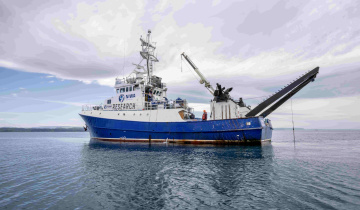Two fossils discovered in the Ormond Valley, near Gisborne, have been identified as a mysterious extinct native fish, the grayling or upokororo. They represent the first known fossils of New Zealand grayling.
Regarded as a 'mystery fish' because it sometimes disappeared from rivers, only to reappear again, the trout-like grayling is our only extinct native freshwater fish. Its only other close relatives are found in Tasmania and southeastern Australia. The grayling was considered by some to be our most abundant freshwater fish, reputed to shoal in its thousands. But by the 1920s or 1930s it had 'vanished', said NIWA freshwater fish expert Dr Bob McDowall, who identified the fossils.
Two Institute of Geological and Nuclear Sciences (GNS Science) scientists discovered several fish fossils in the Ormond Valley (part of the Waipaoa River Catchment), about 10 km inland from Gisborne, while collecting leaf fossils for a climate study in 2003. GNS Science palaeobotanist Dr Liz Kennedy and geologist Dr Brent Alloway found the fossils in sedimentary deposits of a former lake bed.
Earlier this year, the fish fossils were sent to Dr McDowall for identification and two turned out to be "not your everyday fish, but grayling", said Dr Kennedy. Dr McDowall identified the grayling by the position of their fins, number of vertebrae, and the distinctive shape of their forked tails, among other characters.
Dr Alloway estimated the fossil grayling to be about 620,000 years old, based on the known age of volcanic ash deposits found associated with the fossils.
The scientists submitted their discovery to a scientific journal last week.
Background on the fossils
The fossil graylings are about 10 cm long and are not preserved skeletons, but are impressions of the skeletons formed in the fine 'diatomite' rock in which they were found. Diatomite is a very lightweight rock made up from the silica remains of microscopic algae called 'diatoms' that once lived in the lake. Because of the fine grain size of the rock, you can see fine details of fossils, including the scales of fish, said Dr Kennedy.
Background on the New Zealand grayling
Little is known about the New Zealand grayling, Prototroctes oxyrhynchus. It’s thought to have lived in rivers and streams throughout New Zealand and, like its Australian relative, probably spent its larval stage at sea, returning to the rivers as whitebait-like juveniles after several months. This migratory behaviour probably explains its mysterious appearance and disappearance from rivers. The fish probably grew up to 35-45 cm in length and mostly likely fed on algae, said Dr McDowall.
The New Zealand grayling is not related to the European and American graylings, but belongs to a small Australasian family which is related to the southern smelts (genus Retropinna) found in New Zealand’s rivers.
Due to its fine eating and abundance, the grayling was sought after by both Māori and early European settlers. Although no-one knows what caused its extinction, theories include over-fishing, competition from introduced trout and deforestation, which could have affected their food supply, said Dr McDowall.
Ironically, the last authenticated capture of significant numbers of the fish was in c.1923 in the Waiapu River, around 100km north of the fossil site, where anthropologist Sir Peter Buck caught 30 or 40 grayling at a purpose-built weir.
Background on the Ormond Valley deposits
Back in the mid-Pleistocene epoch around 600,000 years ago, the Ormond Valley used to contain a moderate-sized coastal lake (similar in size to Ahuriri Lagoon, near Napier). Over time, sediment, volcanic ash (tephra) from eruptions in the central North Island and the skeletons of plants and aquatic animals accumulated in the lake, forming a sequence of layers which reveals the lake’s past. Leaf and fish fossils are found scattered throughout the fine-grained lake sediment and were first collected from the Ormond Valley in the late 1800s and early 1900s. These early discoveries are now held at Te Papa and GNS Science in Wellington.







